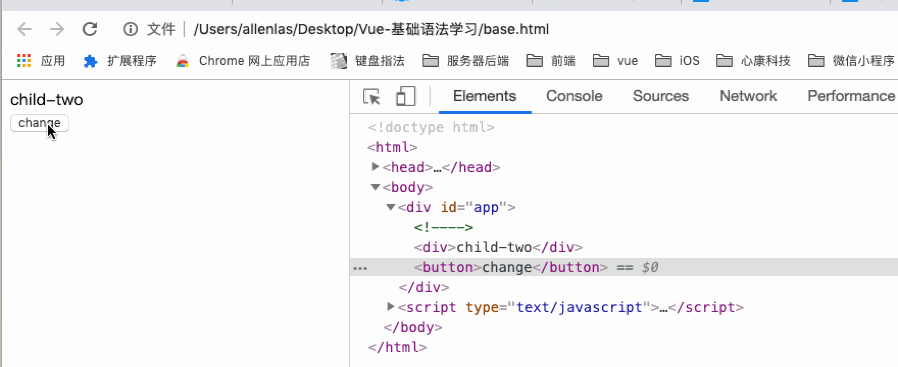Vue 动态组件components和v-once指令的实现
ALLen、LAS 人气:1一、实现两个组件间互相展示、互相隐藏
<!DOCTYPE html>
<html>
<head>
<title>动态组件</title>
<script type="text/javascript" src="./vue-dev.js"></script>
</head>
<body>
<div id="app">
<child-one v-if="type=='child-one'" content="child-one"></child-one>
<child-two v-if="type=='child-two'" content="child-two"></child-two>
<button @click="handleChangeEvent">change</button>
</div>
<script type="text/javascript">
Vue.component('child-one', {
props: ["content"],
template: `<div>{{content}}</div>`,
});
Vue.component('child-two', {
props: ["content"],
template: `<div>{{content}}</div>`,
})
var vm = new Vue({
el: '#app',
data(){
return{
type:'child-one'
}
},
methods:{
handleChangeEvent:function(){
this.type= this.type=="child-one" ? 'child-two':'child-one';
}
}
})
</script>
</body>
</html>
页面效果图如下:

二、动态组件,简化页面代码
使用:父组件 dom标签使用 ,对组件名称进行绑定
<div id="app">
<!-- <child-one v-if="type=='child-one'" content="child-one"></child-one>
<child-two v-if="type=='child-two'" content="child-two"></child-two> -->
<!--动态组件标签component 利用is接收指定标签组件-->
<component :is="type" :content="type"></component>
<button @click="handleChangeEvent">change</button>
</div>
无论使用v-if还是components来使用动态组件的实现,都是在点击交互后,每一次页面效果的切换,会自动销毁前一个组件,再重新创建一个组件,页面则显示响应的内容, 这样的实现方式是比较消耗性能的
三、 v-show和v-once
使用v-show,则会只是隐藏在dom元素中,组件都会被创建。
在子组件中,加入v-once,当每次切换组件效果时,不再需要每次都经过创建-销毁的过程,而是在内存中直接取用上一次使用过的组件的内容
Vue.component('child-one',{
template:'<div v-once>child-one</div>'
})
Vue.component('child-two',{
template:'<div v-once>child-two</div>'
})
使用v-once,可以有效提高静态内容的展示效率,提高性能
加载全部内容